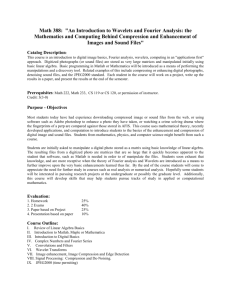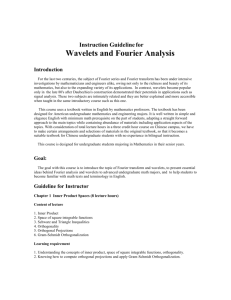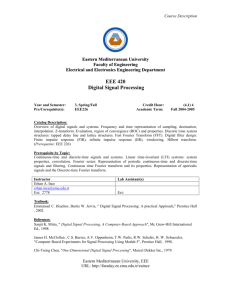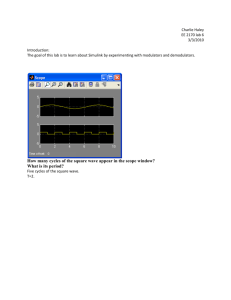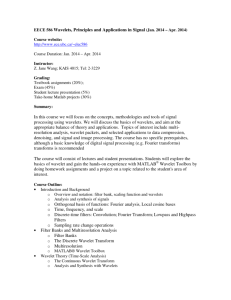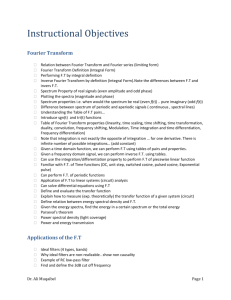Prof. Matteo Manganelli (INF/01, 5 CFU)
advertisement
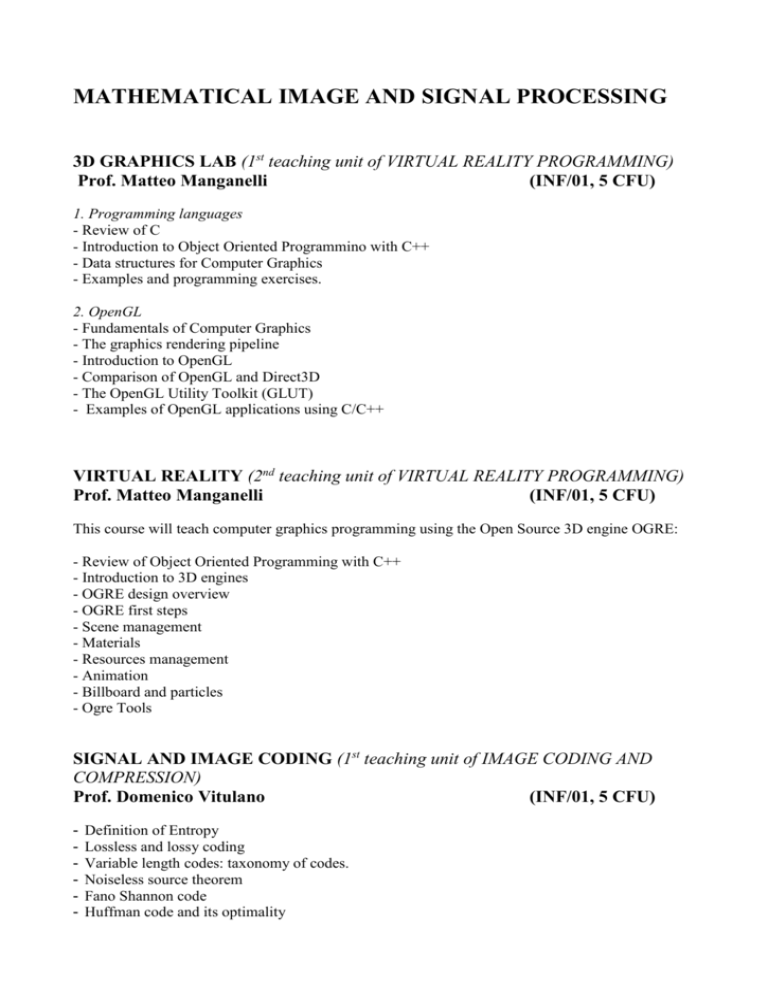
MATHEMATICAL IMAGE AND SIGNAL PROCESSING 3D GRAPHICS LAB (1st teaching unit of VIRTUAL REALITY PROGRAMMING) Prof. Matteo Manganelli (INF/01, 5 CFU) 1. Programming languages - Review of C - Introduction to Object Oriented Programmino with C++ - Data structures for Computer Graphics - Examples and programming exercises. 2. OpenGL - Fundamentals of Computer Graphics - The graphics rendering pipeline - Introduction to OpenGL - Comparison of OpenGL and Direct3D - The OpenGL Utility Toolkit (GLUT) - Examples of OpenGL applications using C/C++ VIRTUAL REALITY (2nd teaching unit of VIRTUAL REALITY PROGRAMMING) Prof. Matteo Manganelli (INF/01, 5 CFU) This course will teach computer graphics programming using the Open Source 3D engine OGRE: - Review of Object Oriented Programming with C++ - Introduction to 3D engines - OGRE design overview - OGRE first steps - Scene management - Materials - Resources management - Animation - Billboard and particles - Ogre Tools SIGNAL AND IMAGE CODING (1st teaching unit of IMAGE CODING AND COMPRESSION) Prof. Domenico Vitulano (INF/01, 5 CFU) - Definition of Entropy Lossless and lossy coding Variable length codes: taxonomy of codes. Noiseless source theorem Fano Shannon code Huffman code and its optimality - Variants of Huffman code Arithmetic coding Overview of universal coding: FGK scheme Dictionary coding: LZ77, LZ78 and LZW Lossy coding: transform based schemes Theory of high bit rate coding Quantization results and compandors Audio signals: A-law and mu-law Run-length 1-D and 2-D Some results of the low bit rate coding The problem of the optimal basis: Karhunen-Loeve JPEG Wavelets and zero-trees Matlab implementation of Huffman and JPEG FRACTAL AND IMAGE COMPRESSION (2nd teaching unit of IMAGE CODING AND COMPRESSION) Prof. Domenico Vitulano (INF/01, 5 CFU) - Overview on fractals Isometries on the real plane Metric spaces, Cauchy and convergent sequences Completeness of a metric space Lipschitz and contractive functions and their properties Banach theorem Hausdorff distance, fractals space and theorem relative its completness Theory of IFS The Collage theorem Some elements of statistics Populations and samples Propagation of an error on a derived of calculated value Likelihood Method Best fit: a general theory Matlab implementation of the best fit Linear prediction Optimal predictor design Delta modulation DPCM Fractal coding: PIFS Matlab implementation of isometries, contractive functions and IFS, generations of some fractals (Sierpinski triangle etc.) COMPUTER VISION (1st teaching unit of MATHEMATICAL ANALYSIS FOR IMAGES) Prof. Riccardo March (MAT/05, 5 CFU) The problem of surface reconstruction from images. Optic and photometric principles of image formation. Reflective properties of surfaces. Lambertian surfaces. Shape from shading. Smoothness constrain on the reconstructed surface. Boundary conditions: occlusions, stereographic projection. Mathematical model and algorithm by Horn and Ikeuchi. Principles of stereo vision. The problem of identifying correspondent points. Binocular disparity and epipolar geometry. Description of a mathematical model and an algorithm for stereo reconstruction. The problem of optical flow: estimate of the velocity vector field of moving objects from temporal sequences of images. Smoothness constraint on the optical flow. Mathematical model and algorithm by Horn and Schunck. Unitary mathematical framework: computer vision problems as ill-posed inverse problems. An outline of Tikhonov regularization theory. Regularization with discontinuities: meaning of discontinuous solutions. Link between occlusions and discontinuities. Blake and Zisserman’s approach. Detailed description of algorithms for the numerical solution of the following problems: shape from shading, visible surface reconstruction from pairs of stereo images, computation of optical flow. 3D ANIMATION (2nd teaching unit of 3D MODELING AND ANIMATION) Prof. Alessandro Pandolfi (INF/01, 5 CFU) - History of Animation From stone age to 3D Traditional 2D animation techniques Occidental vs Japan animation Comparison between 2D and 3D animation Brief introduction to 3D software (Maya) • Basic interface - Viewport navigation instruments - Basic Animation tools - Introduction to the Graph Editor\Dope Sheet - Fcurve's manipulation - Animation Workflow • Animator's role - Planning animation - Organized Key framing • Animation Techniques • 12 Principles of Animation - Squash & Stretch - Anticipation - Staging - Straight Ahead Action vs Pose to Pose Action - Follow Through and Overlapping Action - Slow In and Slow Out or Eases - Arcs - Secondary Action - Timing - Exaggeration - Solid Drawing - Appeal • Animating Forces , Internal and External Forces - Inertia - Weight - Energy level Force Transmitted through Flexible Joint Jointed Limbs Progressive Break of Joints • Posing & Shape - Line of Action (Flow Lines) - Balance - Sense of Weight - Defining the Character (Outer expression of Inner realities) • Facial Animation The Golden Triangle - Facial Expressions at the posing stage - Eyes movement - Blinks - Eye Darts - Lip-Sync • Basic Acting for Animators WAVELETS AND SPLINES (1st teaching unit of WAVELETS: this unit course covers, in alternate years, splines and/or wavelets.) Prof. Carla Manni (MAT/08, 7 CFU) The course covers, in alternate years, splines and/or wavelets. As for splines, it presents an introduction to construction and main properties of splines and wavelets with special emphasis to their application in imaging processing. Topics: splines and B-splines, construction and main geometric properties. The topics covered on wavelets are: Wavelet transform. Multiresolution analysis: decomposition and reconstruction algorithms. Smooth, orthonormal and compactly supported wavelets. Spline wavelets. Examples and applications. FRAMES (2nd teaching unit of WAVELETS) Prof. Sandra Saliani (MAT/05, 5 CFU) Riesz basis. Riesz basis of translates. Generalized multiresolution analysis (GMRA). Dual GMRA. A discrete transform for biorthogonal Wavelets. Compactly supported biorthogonal Wavelets. Frames in Hilbert spaces. Dual frames. Tight frames. The frame operator. Redundancy of frames. Frames of translates. Frames of exponentials. Gabor frames in L2(R). Necessary and sufficient conditions for Gabor frames. The representation of the Gabor frame operator. The Zak transform. Applications of Gabor frames. Wavelet frames. Necessary and sufficient conditions for Wavelet frames. Dyadic Wavelet frames. Frames multiresolution analysis. Textboos: - D. Walnut, An Introduction to Wavelet Analysis, Birkhauser, Basel, 2001 online notes, Analisi di Fourier e trattamento numerico dei segnali WAVELET LAB Prof. Vittoria Bruni (INF/01, 5 CFU) - Introduction to Matlab - Discrete Fourier Transform - Comparison between the Short time Fourier Transform and the Continuous Wavelet Transform - Subband coding and filter banks: Implementation of the DiscreteWavelet Transform (with and without the Matlab wavelet toolbox) -Wavelets and filters: vanishing moments, compact support -Families of wavelets -Criteria for the selection of an appropriate wavelet -Characterization of singularities Applications: Denoising (thresholding, shrinkage, ...), Compression (zero-tree, entropy coding,...), Edge Detection (2D-WT and maxima of its modulus) HARMONIC ANALYSIS Prof. Massimo Picardello (MAT/05, 6 CFU) Review of orthonormal expansions in Hilbert space. Fourier series and their convergence in L2. Criteria for pointwise and uniform convergence of Fourier series. The rate of decay of Fourier coefficients. Gibbs phenomenon. Convergence of approximate identities. The Fourier transform and its properties. Rate of decay of Fourier transforms. The Plancherel theorem and the inversion formula. Convergence induced by families of semi-norms. The Schwartz class. Outline of duality for Banach and Frechet spaces. Tempered distributions. Convergence in the distribution sense for sequences and series of tempered distributions. Differentiation and convolution of tempered distributions. Fourier transform of a tempered distribution. The sampling process in terms of distributions. The Poisson inversion formula. Whittaker expansions and the Shannon sampling theorem. Aliasing. The Discrete Fourier Transform and its properties. The Fast Fourier Transform. Textbook: online notes, Analisi di Fourier e trattamento numerico dei segnali H.Dym, H.P.McKean, Fourier Series and Integrals, Academic Press, New York, 1972 W. Rudin, Functional Analysis, 2nd edition, McGraw-Hill, New York, 1991 COMPUTER GRAPHICS (1st teaching unit of 3D RENDERING, for students without previous experience of elementary computer graphics) Prof. Massimo Picardello (MAT/05, 5 CFU) Color theory. Perspective transformations: parallel and central projections, vanishing points, 3D hidden lines removal. Stereoscopic projections. Euler angles. Rotations in 3D. Quaternions. Image sampling and aliasing; filtering. Octrees. Clipping in 3D. Image and object precision. Coherence. Hidden area removal: z-buffer. BSP. Scan line. Warnock method. Atherton-Weiler method. Ray Tracing. Rendering of 3D scenes: lights and euristic models of illumination. Lambert diffusion. Phong model. Shading and interpolation. Physics-based models for surface diffusion and reflection. Rendering with mapping: texture map, bump map, reflection map. Methods for shadows: Williams, Atherton-Weiler-Greenberg. Transparency: double z-buffer, Snell law for refraction. Recursive Ray Tracing and methods for acceleration. Radiosity. Form factors and their computation. Substructuring. Iterative solutions: Jacobi, GaussSeidel and Southwell relaxation. Progressing refinement. Hints of multi-pass methods. Textbooks: J.Foley, A. van Dam, S.Feiner, J.Hughes, Computer Graphics: Principles and Practice, 2nd edition in C, Addison-Wesley, Reading (Mass.), 1996 online notes, Algoritmi e metodi analitici, numerici e statistici in Computer Graphics GLOBAL ILLUMINATION (2nd teaching unit of 3D RENDERING) Prof. Massimo Picardello (MAT/05, 5 CFU) Radiometry, photometry, bidirection reflectance distribution function, flux, radiance, the rendering equation: hemisphere and area formulation. Probabilistic methods for computing integrals: Monte-Carlo, samples with assigned distribution, variance and variance-minimizing probability distribution. Variance reduction, stratified sampling. Importance function and the Green kernel of the rendering operator: Global reflectance distribution function. Stochastic Ray Tracing and its variance. Stochastic radiosity: stochastic Jacobi relaxation, discrete random walk methods, continuous random walks (photon tracing), variance of all these methods. Outline of multipass methods: final gathering, Metropolis light transport, Irradiance caching. Photon mapping, photon density and radiance gathering via nearest neighbour photons, light transports used in gathering Textbooks: Ph.Dupré, Ph.Bekaert, K.Bala, Advanced Global Illumination, A.K.Peters, Natick (Mass.), 2003 online notes, Algoritmi e metodi analitici, numerici e statistici in Computer Graphics PHOTON MAP (in alternative to GLOBAL ILLUMINATION: this course deals with the photon map method only, but requires autonomous computer coding, normally in C++) (MAT/08, 5 CFU) Prof. Massimo Picardello Radiometry, photometry, bidirection reflectance distribution function, flux, radiance, the rendering equation: hemisphere and area formulation. Probabilistic methods for computing integrals: Monte-Carlo, samples with assigned distribution, variance and variance-minimizing probability distribution. Variance reduction, stratified sampling. Photon mapping, photon density and radiance gathering via nearest neighbour photons, light transports used in gathering. Development of working computer code for rendering with the photon map method. Textbook: H.W.Jensen, Photorealistic Image Rendering with Photon Map, A.K.Peters, Natick (Mass.), 2002 TOMOGAPHY (1st teaching unit of IMAGE RECOGNITION AND RECONSTRUCTION) (MAT/05, 5 CFU) Prof. Massimo Picardello Review of Fourier transform in L2, Shannon sampling theorem, tempered distributions, holomorphic functions. Outline of the Hilbert transform. Outline of Bessel functions and applications to diffraction tomology. The Radon transform and the Fourier slice theorem. The dual operator: back projection. Examples of inversion theorems of the Radon transform: the use of the Hilbert transform. Textbooks: A.C.KaK, M.Slaney, Principles of Computerized Tomographic Imaging, SIAM 2001 (chapters 3,4,6) G.T. Herman, Image Reconstruction from Projections, Academic Press, New York, 1980 (chapter 8 and chapter 16 sect.6) course notes by the instructor ELEMENTS OF FUNCTIONAL ANALYSIS (MAT/05, 6 CFU) Prof. Lucio Damascelli (Warning: this course, shared with the Faculty of Engineering, starts approximately ten days before the normal starting date, that is around the 21st of September) Review of metric spaces, normed spaces, inner product spaces, separability, completeness, connectedness, compactness, uniform continuity and the contractive fixed point theorem and its applications - Spaces of continuous functions: theorems of Ascoli-Arzela' and Stone-Weierstrass - Bounded linear operators on Banach spaces - The Lebesgue integral on Rn; Lp spaces - Hilbert spaces, orthogonal projections and best approximation, the Riesz representation theorem - Orthogonal systems, Fourier series in Hilbert spaces, Fourier series in L2, sketch of criteria for pointwise or uniform convergence - Linear operators on Hilbert spaces, compact self-adjoint operators on separable Hilbert spaces and their spectral decomposition - Short outline on the Uniform Boundedness theorem and weak topology - Some outline on the Fourier transform on L1 and L2 - Elements of function theory in one complex variable, with emphasis on calculus of residues Textbook: course notes by the instructor RENDERING LAB Prof. Massimo Picardello (INF/01, 8 CFU) This course is aimed to the development of a complete physically based photorealistic renderer and shader. The full aim can not be reached in one year, but only putting together the material covered in two or three subsequent editions of the course. The students should be familiar with the C++ programming language, and possibly skilled programmers, because they will not be assisted in computer coding, only in mathematical and algorithmic aspects. The mathematical aspects cover geometry, linear transformations and perspective transformations, shapes and meshing, sampling (including anti-aliasing), probabilistic sampling (including stratified and low discrepancy), filters, MonteCarlo integration, reduction of variance. The algorithmic aspects include kd-trees, radiometry, models for light reflection and diffusion, BSDF, bump mapping, texture construction and texture mapping, volume scattering and phase function, light transport, the rendering equation, path tracing, irradiance caching, photon mapping, volume rendering with participating media. All these topics are covered in prerequisite courses (Computer Graphics, Global Illumination), but here the student will be asked to develop code to implement these ideas in the renderer. Textbook: M.Pharr, G.Humphreys, Physically Based Rendering, from Theory to Implementation, Morgan Kaufmann (Elsevier), S.Francisco, 2004 NUMERICAL METHODS FOR PARTIAL DIFFERENTIAL EQUATIONS AND IMAGE RESTORATION Prof. Daniele Bertaccini Finite difference approximations Boundary Value Problems and steady state Elliptic equations The initial value problems for ODEs Diffusion equations and parabolic problems Advection equations and hyperbolic systems Mixed-type partial differential equations (PDEs) Smoothing PDEs Nonlinear diffusion Smoothing-Enhancing PDEs Chemotaxis PDEs References [1] R. J. LeVeque -- Finite Difference Methods for ODEs and PDEs, Steady State and Time Dependent Problems. SIAM, Philadelphia, 2007 [2] G. Aubert, P. Kornprobst, Mathematical Problems in Image Processing. Partial Differential Equations and the Calculus of Variation, Springer, 2006
